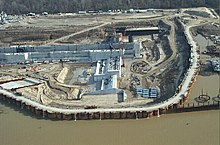Cofferdam


A cofferdam (also called coffer[1]) is an enclosure within a water environment constructed to allow water to be displaced by air for the purpose of creating a dry work environment. Commonly used for oil rig construction and repair, bridge and dam work, the cofferdam is usually a welded steel structure that is temporary, typically dismantled after work is completed. Its components consist of sheet piles, wales, and cross braces.
The cofferdam is also used on occasion in the shipbuilding and ship repair industry, when it is not practical to put a ship in drydock for repair or alteration. An example of such an application is certain ship lengthening operations. In some cases a ship is actually cut in two while still in the water, and a new section of ship is floated in to lengthen the ship. Torch cutting of the hull is done inside a cofferdam attached directly to the hull of the ship, and is then detached before the hull sections are floated apart. The cofferdam is later replaced while the hull sections are welded together again. As expensive as this may be to accomplish, use of a drydock may be even more expensive. See also caisson.

Cofferdams have also been used to recover ships sunk in shallow waters, such as the USS Maine, or Robert de LaSalle's La Belle.
Naval architecture
A cofferdam may also refer to an insulating space between two watertight bulkheads or decks within a ship. A cofferdam may be a void (empty) space or a ballast space. Cofferdams are usually employed to ensure oil or other chemicals do not leak into machinery spaces. If two different cargoes that react dangerously with each other are carried on the same vessel, one or more cofferdams are usually required between the cargo spaces.
The division between the tanks and the hull of a double-hulled vessel is not normally called a cofferdam, although it carries this function.
References
- ^ "Coffer", The American Heritage Dictionary of the English Language, Fourth Edition. Houghton Mifflin Company, 2004. (accessed 16 Jan. 2008)
